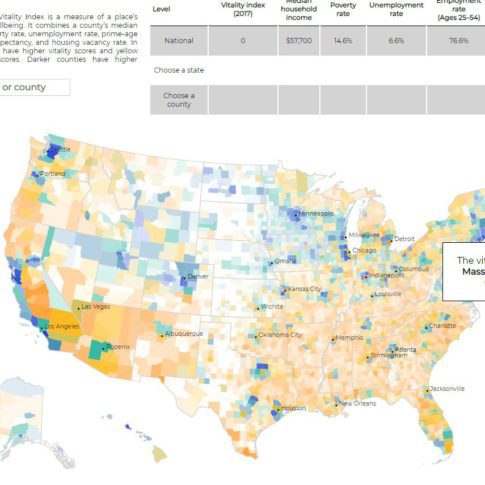In the Great Recession, job growth was sharply negative for nearly two years. As a result, the employment rate for prime-age workers (i.e., the employment-to-population ratio for those aged 25 to 54) fell by 5 percentage points from 2007 to 2010.
But that decline in the employment rate pales in comparison to the regional gaps in employment rates. Today, prime-age employment rates are 16 percentage points lower in the bottom quintile of counties compared to those at the top. This gap is equivalent to bottom-quintile counties facing three Great Recession declines relative to top counties—a stark measure of the varying employment opportunities and outcomes that Americans face depending on their location. A new Hamilton Project interactive based on work from a recent Hamilton Project paper (The Geography of Prosperity) enables users to explore—down to the state and county level—where and how places are struggling or thriving throughout the United States. Gaps in employment rates, along with gaps in other variables like life expectancy and poverty rates, are immediately evident when comparing thriving places like Denver, Colorado with struggling places like Dayton, Ohio. Americans in many ways experience a different economy based on where they live, generating substantial gaps in life outcomes. The typical household income in the wealthiest 20 percent of counties is more than twice that in the poorest 20 percent, and that gap increased substantially from 1980 to 2017. Poverty rates are three times higher in the poorest 20 percent of counties compared to the top counties. Life expectancy is 6 years longer in top performing counties than those at the bottom. To put this gap into context, it has taken about 4 decades for U.S. life expectancy to rise 6 years, so the gap across counties is the equivalent of 4 decades of progress. To present a more complete picture of which places are thriving, The Hamilton Project created the Vitality Index, which measures the economic and social well-being of a place. The index combines the following measures:
- median household income,
- poverty rate,
- unemployment rate,
- prime-age employment-to-population ratio,
- housing vacancy rate, and
- life expectancy.
Using a statistical procedure that can isolate the underlying common factor among these variables, we found that having a high median household income, a low poverty rate, and high life expectancy were the most important indicators of a county’s vitality.  Figure 1 shows the Vitality Index for 2017, based on data from 2013–17, with blue counties receiving the highest scores and yellow counties receiving the lowest. The map also depicts relative population by representing populous areas in darker colors and sparsely populated areas with lighter colors. Much of the California coast, therefore, is shown in a dark blue, indicating its high population and high vitality. There are broad regional patterns: the corridor from Boston to Washington, DC has a large concentration of high vitality counties, as does the upper Great Plains and the California coast, while the Southeast and Southwest have a number of low vitality places. However, there are also many struggling places in the Northeast and successful places in the South. Vitality varies widely across counties and not only across regions. The new interactive tool allows users to explore the vitality index and its components across the country. While the vitality index is created at the county level, one can also see state averages in the interactive and in figure 2 below.
Figure 1 shows the Vitality Index for 2017, based on data from 2013–17, with blue counties receiving the highest scores and yellow counties receiving the lowest. The map also depicts relative population by representing populous areas in darker colors and sparsely populated areas with lighter colors. Much of the California coast, therefore, is shown in a dark blue, indicating its high population and high vitality. There are broad regional patterns: the corridor from Boston to Washington, DC has a large concentration of high vitality counties, as does the upper Great Plains and the California coast, while the Southeast and Southwest have a number of low vitality places. However, there are also many struggling places in the Northeast and successful places in the South. Vitality varies widely across counties and not only across regions. The new interactive tool allows users to explore the vitality index and its components across the country. While the vitality index is created at the county level, one can also see state averages in the interactive and in figure 2 below.  In figure 1, Oregon appears to be made up of counties that mostly have low vitality scores. However, in figure 2, the state of Oregon overall has an average vitality score. This is because a large portion of Oregon’s population lives in and around Portland—Washington County, a prominent Portland suburb, has a vitality score of 0.91, which is in the top quintile of counties. On the other end of the spectrum, Baltimore County in Maryland has an extremely low vitality score of -1.41, placing it in the bottom quintile of counties. However, putting it all together at the state level, Maryland has the highest vitality score of all the states due to its prosperous suburban counties. What explains the vitality of a place?
In figure 1, Oregon appears to be made up of counties that mostly have low vitality scores. However, in figure 2, the state of Oregon overall has an average vitality score. This is because a large portion of Oregon’s population lives in and around Portland—Washington County, a prominent Portland suburb, has a vitality score of 0.91, which is in the top quintile of counties. On the other end of the spectrum, Baltimore County in Maryland has an extremely low vitality score of -1.41, placing it in the bottom quintile of counties. However, putting it all together at the state level, Maryland has the highest vitality score of all the states due to its prosperous suburban counties. What explains the vitality of a place?
- A county’s average level of educational attainment (in terms of high school and college completion) is the strongest predictor of vitality. Relatedly, places that were highly innovative in 1975 (as measured by patent activity) are still more vital today.
- Places with higher population density in 1980 fared better today.
- The vitality index is quite stable, showing strong persistence from 1980 to today, with a few exceptions. In particular, counties with a high share of employment in manufacturing in 1980 and counties with a high concentration of employment in one industry tended to fare worse over time.
One factor that can reinforce these differences in economic outcomes across places is the quality of investments in local public goods. State and local governments that are struggling may have difficulty paying for such investments, which in turn limits economic opportunity for residents. Another reinforcing factor of geographic disparities is the decline in migration rates. Though decreased migration rates could be a cause for concern in their own right, low and falling mobility could also play a role both in exacerbating economic disparities between places and in slowing the rate of convergence. Declining migration does make it more likely that the benefits of place-based policies will reach local residents, rather than being captured by those who move to the struggling location, or by landowners. For much of the 20th century, the large gaps between regions were closing as poorer places grew faster, converging with higher income locations. Since around 1980, though, that convergence has stopped, leaving sizable gaps in economic outcomes across places. Our recent Hamilton Project book, Place-Based Policies for Shared Economic Growth, provides a number of policy options that could help restore growth to struggling regions. And our new interactive tool allows you to explore these gaps and see what components of the index drive them. The screenshot below gives a sense of the information provided by the interactive, showing, in addition to a county’s vitality, the median household income, poverty rate, unemployment rate, prime-age employment rate, housing vacancy rate, and life expectancy. 




